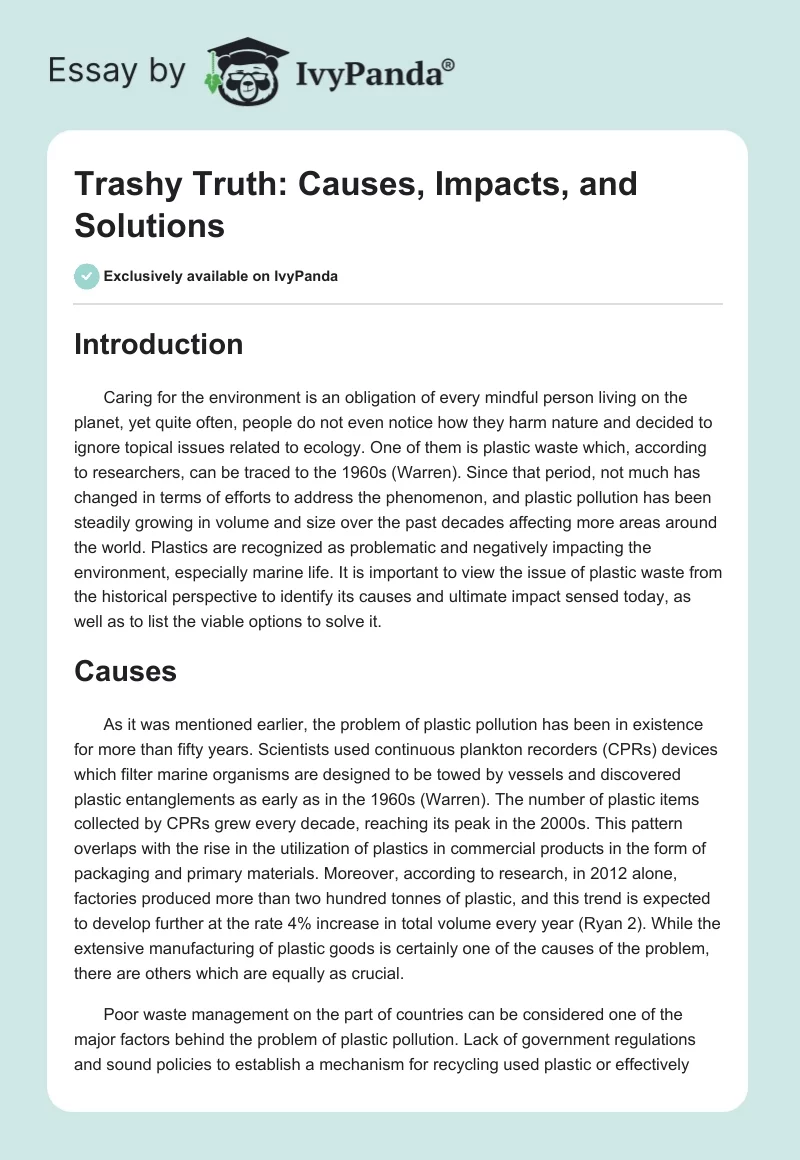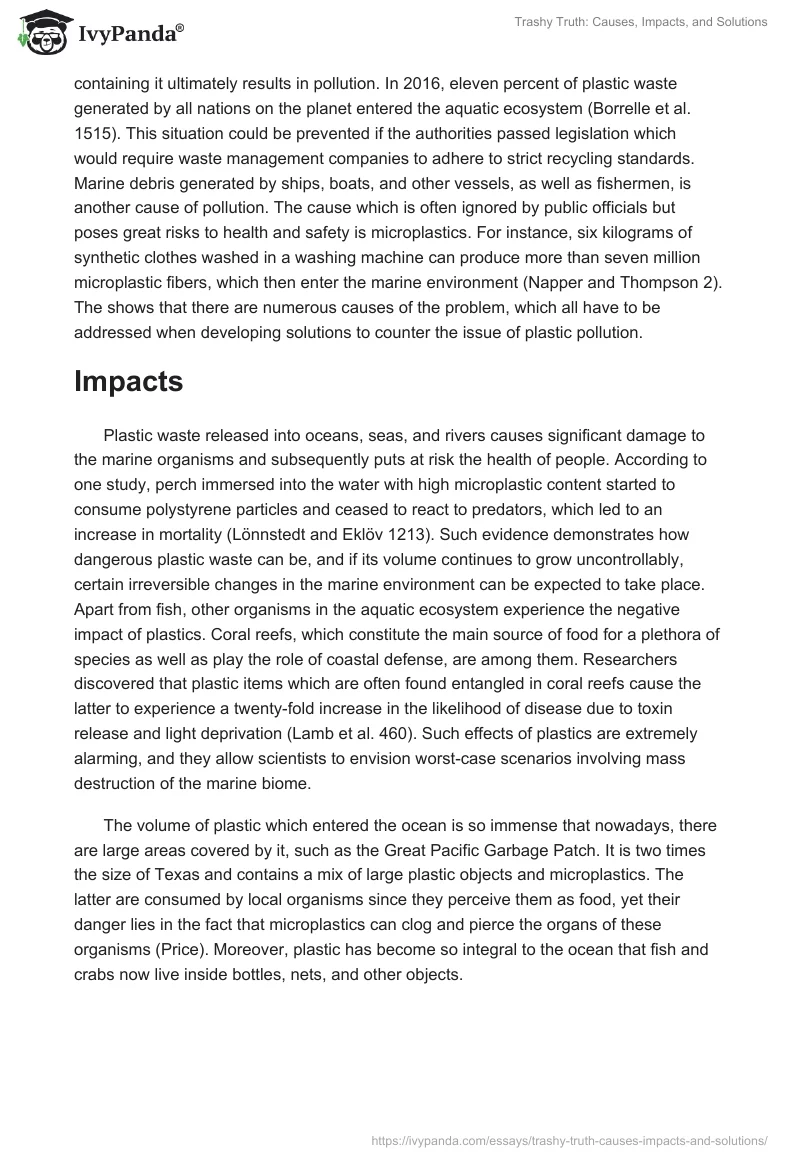Introduction
Caring for the environment is an obligation of every mindful person living on the planet, yet quite often, people do not even notice how they harm nature and decided to ignore topical issues related to ecology. One of them is plastic waste which, according to researchers, can be traced to the 1960s (Warren). Since that period, not much has changed in terms of efforts to address the phenomenon, and plastic pollution has been steadily growing in volume and size over the past decades affecting more areas around the world. Plastics are recognized as problematic and negatively impacting the environment, especially marine life. It is important to view the issue of plastic waste from the historical perspective to identify its causes and ultimate impact sensed today, as well as to list the viable options to solve it.
Causes
As it was mentioned earlier, the problem of plastic pollution has been in existence for more than fifty years. Scientists used continuous plankton recorders (CPRs) devices which filter marine organisms are designed to be towed by vessels and discovered plastic entanglements as early as in the 1960s (Warren). The number of plastic items collected by CPRs grew every decade, reaching its peak in the 2000s. This pattern overlaps with the rise in the utilization of plastics in commercial products in the form of packaging and primary materials. Moreover, according to research, in 2012 alone, factories produced more than two hundred tonnes of plastic, and this trend is expected to develop further at the rate 4% increase in total volume every year (Ryan 2). While the extensive manufacturing of plastic goods is certainly one of the causes of the problem, there are others which are equally as crucial.
Poor waste management on the part of countries can be considered one of the major factors behind the problem of plastic pollution. Lack of government regulations and sound policies to establish a mechanism for recycling used plastic or effectively containing it ultimately results in pollution. In 2016, eleven percent of plastic waste generated by all nations on the planet entered the aquatic ecosystem (Borrelle et al. 1515). This situation could be prevented if the authorities passed legislation which would require waste management companies to adhere to strict recycling standards. Marine debris generated by ships, boats, and other vessels, as well as fishermen, is another cause of pollution. The cause which is often ignored by public officials but poses great risks to health and safety is microplastics. For instance, six kilograms of synthetic clothes washed in a washing machine can produce more than seven million microplastic fibers, which then enter the marine environment (Napper and Thompson 2). The shows that there are numerous causes of the problem, which all have to be addressed when developing solutions to counter the issue of plastic pollution.
Impacts
Plastic waste released into oceans, seas, and rivers causes significant damage to the marine organisms and subsequently puts at risk the health of people. According to one study, perch immersed into the water with high microplastic content started to consume polystyrene particles and ceased to react to predators, which led to an increase in mortality (Lönnstedt and Eklöv 1213). Such evidence demonstrates how dangerous plastic waste can be, and if its volume continues to grow uncontrollably, certain irreversible changes in the marine environment can be expected to take place. Apart from fish, other organisms in the aquatic ecosystem experience the negative impact of plastics. Coral reefs, which constitute the main source of food for a plethora of species as well as play the role of coastal defense, are among them. Researchers discovered that plastic items which are often found entangled in coral reefs cause the latter to experience a twenty-fold increase in the likelihood of disease due to toxin release and light deprivation (Lamb et al. 460). Such effects of plastics are extremely alarming, and they allow scientists to envision worst-case scenarios involving mass destruction of the marine biome.
The volume of plastic which entered the ocean is so immense that nowadays, there are large areas covered by it, such as the Great Pacific Garbage Patch. It is two times the size of Texas and contains a mix of large plastic objects and microplastics. The latter are consumed by local organisms since they perceive them as food, yet their danger lies in the fact that microplastics can clog and pierce the organs of these organisms (Price). Moreover, plastic has become so integral to the ocean that fish and crabs now live inside bottles, nets, and other objects.
Solutions
Nevertheless, despite the fact that plastic waste has already inflicted considerable damage to the marine ecosystem, there are ways to solve the problem and potentially reverse the detrimental effects of pollution. The main measure in response to the plastic waste crisis must be the adoption and implementation of reliable policies. For instance, the government can mandate producers to add information about correct ways of disposal of plastic for consumers. Additionally, countries can invest in research of new materials which could replace plastic and innovative methods of recycling. The ultimate goal here is to create a system which would maintain a loop use of plastic without the necessity to deposit wastes in landfills (Worm et al. 2). To combat the spread of microplastics, cities can build water purification facilities which would filter out small plastic particles before releasing the water into rivers and the ocean.
The existing volumes of waste which have been accumulated in the ocean over past decades have to be reduced and ultimately removed. Researchers already have designed and successfully deployed devices which allow to collect debris. The Ocean Cleanup, a team of scientists, developed a floating system which catches waste in the ocean which then gets recycled into different products such as sunglasses (“Cleaning Up”). The company promises to clean fifty percent of the Great Pacific Garbage patch in a matter of five years which demonstrates that the technological advancements constitute a viable solution for the problem of plastic pollution. Finally, according to Brian Hutchinson, people also can contribute to the fight against plastic debris by reducing their use of disposable plastic, avoiding products with microbeads, and supporting green policies (Hutchinson). Thus the response to the problem of plastic pollution must be four-fold and include legislation, investments in infrastructure and research, clean-up efforts, and responsible conduct on the part of citizens.
Conclusion
The problem of plastic waste has been a topical one for several decades, and it remains to be unresolved, which implies a considerable threat to the health and safety of both marine organisms, animals, and people. Historically, the first evidence of plastic pollution in the marine environment date back to the 1960s, the onset of the period of mass consumption, which saw a rapid increase in the use of plastic. Apart from the overproduction of plastics, the main causes of the phenomena relate to the lack of legislation which would strictly regulate recycling which leads to poor waste management. As a result, currently, more than ten percent of plastic waste enters the aquatic ecosystem every year, which harms fish, crabs, plankton, and many other organisms. The solution to the problem must involve the adoption of sound laws related to plastic recycling, investments in plastic alternatives, clean-up programs, and citizens’ personal efforts to avoid extensive use of plastics.
Works Cited
“Cleaning Up the Garbage Patches.”The Ocean Cleanup, n.d., Web.
Borrelle, Stephanie B. et al. “Predicted Growth in Plastic Waste Exceeds Efforts to Mitigate Plastic Pollution.” Science, vol. 369, no. 6510, 2020, pp. 1515–1518. Web.
Hutchinson, Brian. “7 Ways to Reduce Ocean Plastic Pollution Today.”Ocean Society, 2020, Web.
Lamb, Joleah, B. et al. “Plastic Waste Associated with Disease On Coral Reefs.” Science, vol. 359, no. 6374, 2018, pp. 460–462. Web.
Lönnstedt, Oona M. and Eklöv, Peter. “Environmentally Relevant Concentrations of Microplastic Particles Influence Larval Fish Ecology.” Science, vol. 352, no. 6290, 2016, pp. 1213–1216. Web.
Napper, Imogen, Ellen and Thompson, Richard, C. “Plastic Debris in the Marine Environment: History and Future Challenges.” Global Challenges, vol. 4, no. 6, 2020, pp. 1–9. Web.
Price, Chelcee. Toxic Ecosystems: The Impact of Plastic on Marine Life. Greenpeace, 2018, Web.
Ryan, Peter, G. “A Brief History of Marine Litter Research.” Marine Anthropogenic Litter, edited by Melanie Bergmann, Lars Gutow and Michael Klages, Springer, 2015, pp. 1–25.
Warren, Matthew. Planet’s Ocean-plastics Problem Detailed In 60-year Data Set. Nature, 2019, Web.
Worm, Boris, et al. “Plastic as a Persistent Marine Pollutant.” Annual Review of Environment and Resources, vol. 42, 2017, pp. 1–26. Web.


